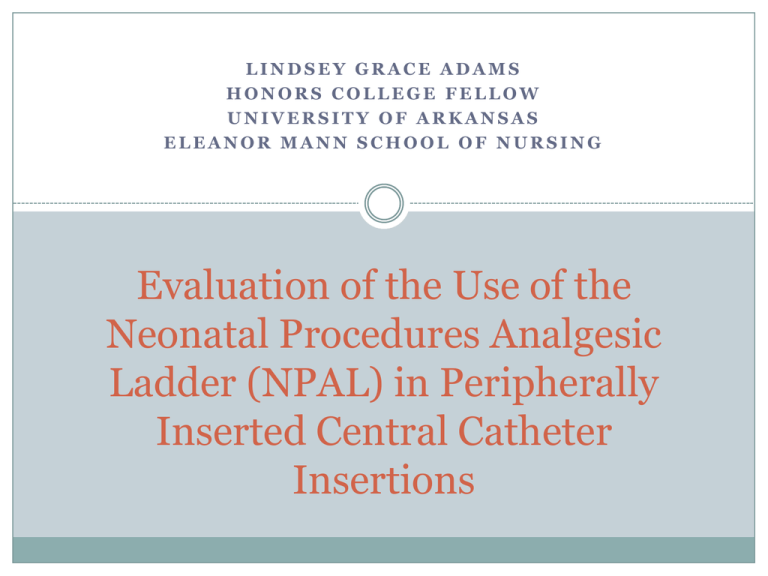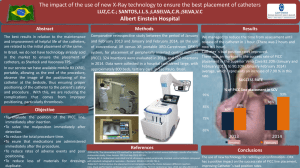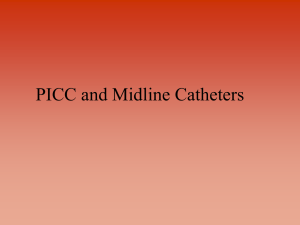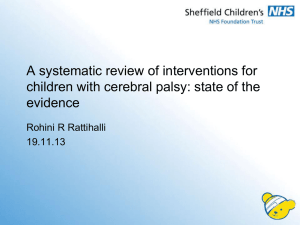Evaluation of the Use of the Neonatal Procedures Analgesic Ladder
advertisement

LINDSEY GRACE ADAMS HONORS COLLEGE FELLOW UNIVERSITY OF ARKANSAS ELEANOR MANN SCHOOL OF NURSING Evaluation of the Use of the Neonatal Procedures Analgesic Ladder (NPAL) in Peripherally Inserted Central Catheter Insertions Neonate Pain Pain, as defined by the International Association of Pain, is the “unpleasant sensory and emotional experience associated with actual or potential tissue damage, or described in terms of such damage.” Despite the understanding that neonates endure frequent painful procedures, pain is frequently not treated adequately or effectively in neonates . Unresolved, prolonged pain in infants may delay procedural recovery and inhibit the healing of infections and diseases thus resulting in increased health care costs Neonatal Infant Pain Scale (NIPS) The use of a multi-dimensional assessment is necessary for neonates because they lack the ability to self report their pain level Based on five behavioral items- facial expression, crying, arms, legs, state of arousal, and the physiologic indicator assessing breathing patterns An intraclass correlation coefficient with a 95% confidence interval was 0.98 indicates that the NIPS has exceptional reliability correlating with other neonate pain scales Pharmacologic vs. Nonpharmacologic Pain Management Pharmacologic Pain Interventions- Opioid analgesics, topical anesthetics, sedatives, hypnotics, and nonopioid analgesics Nonpharmacologic Pain Management Examples- Facilitated tucking or swaddling, non-nutritive sucking, sucrose, and skin-to-skin Peripherally Inserted Central Catheters (PICC) Long-term IV catheters used for medicine and electrolyte administration, collecting blood samples, or parenteral nutrition, and PICC lines minimize the pain of repeated venipuncture Since the 1970s, PICC lines have been used in infants in the NICU who require long-term intravenous hyperalimentation, medication, or electrolyte administration, or blood sampling. Neonatal Procedures Analgesic Ladder (NPAL) Pain intervention protocol for managing neonate pain during painful procedures, including PICC line insertions K. Anand via personal communication has said that the NPAL tool may be used in the current study. NPAL protocol steps during PICC line insertions Step 1- Using a pacifier with sucrose and swaddling or facilitated tucking Step 2- Applying topical EMLA cream Step 3- Acetaminophen, orally or rectally Step 4- Slow IV opioid infusion of morphine or fentanyl Step 5- Subcutaneous infiltration or nerve blocks Step 6- General anesthesia or deep sedation if necessary Purpose The purpose of this study is to evaluate the use of the Neonatal Procedures Analgesic Ladder (NPAL) in an urban hospital Neonatal Intensive Care Unit (NICU) in Northwest Arkansas. Aim 1 Aim 1: To determine if the implementation of NPAL nursing policy changes pain interventions prior to insertion of PICC lines. Research Question 1: What is the level of compliance of staff with the NPAL nursing protocol following implementation? Research Question 2: Are there differences in types and frequencies of neonate pain interventions post NPAL implementation for PICC insertions? Aim 2 Aim 2: To determine if there is a difference in post procedural pain levels of neonates who receive PICC insertions. Research Question 1: Is the Neonatal Infant Pain Scale (NIPS) score lower post procedure following implementation of the NPAL protocol? Approval and Funding Received an Honors College Undergraduate Research Grant The University of Arkansas’ Institutional Review Board (IRB) approval and the hospital’s IRB approval were obtained prior to data collection Slow progress in receiving approval contributed to the small sample size Sample Infants admitted to the NICU of an urban hospital in Northwest Arkansas between November 1, 2010 and February 28, 2011 requiring a PICC line Must have parental consent form signed for chart review The sample size was 22 with 18 including usable data due to the limited number of PICC lines inserted during the allotted time frame Design Retrospective chart review evaluating the effectiveness of the NPAL protocol implementation before, during, and after PICC insertions Study variables will include NIPS rating before, during, and 10 minutes after PICC insertion and types of pain management interventions used. Demographic information will be collected on all infants. Following chart review, there will be no way to trace information back to the individual patient. Study Variable Definitions Gestational Age: Infant age as calculated from counting weeks since mother’s last menstrual period Chronological Age: Age of infant since day of birth Oxygen Administration: O2 during PICC insertion EMLA Cream: Application of topical lidocaine and prilocaine mixture 30 minutes prior to insertion SQ Lidocaine: Subcutaneous lidocaine injection 30 minutes prior to PICC insertion Acetaminophen- Oral or rectal administration IV opioids- Usually Fentanyl intravenously Nerve Blocks and General Anesthesia: Rarely used during PICC insertions Sucrose: Oral sucrose solution administered with pacifier during PICC insertion Study Variable Definitions (Continued) Neutral Thermal Environment: Incubator or warmer used to maintain basal body temperature or specifically during PICC insertion for comfort Removing wet diaper: Changing diaper prior to PICC insertion Cluster Care: Limiting touch time and clustering activities, not included because non clearly defined in the protocol and poorly documented Distraction: Tactile stimulation, music, or vocalization during PICC insertion Pacifier: Given during insertion for non-nutritive sucking or in association with the sucrose Swaddling / Facilitated Tucking / Containment: Similar terms referring to wrapping the infant in a secure position Repositioning: Changing the infant’s position for comfort or to facilitate the PICC line insertion Elements of Chart Review Demographics of Sample Gender Male 11 Female 7 Ethnicity Caucasian 16 Hispanic 2 African American 0 Gestational Age at Birth 38-40 weeks 2 30-38 weeks 11 Less than 30 weeks 5 Pre-, During, and Post-NIPS Scores Pre-procedure, During, and Post-procedure NIPS Scores 1.6 1.4 1.2 1 0.8 Series1 Series2 0.6 0.4 0.2 0 Pre NIPS Score Highest Pain Score Post NIPS Score Types and Frequency of Pain Management Interventions Used Types and Frequency of Pain Management Interventions Used 100.00% 90.00% 80.00% 70.00% 60.00% 50.00% 40.00% 30.00% 20.00% 10.00% 0.00% Pain Management Interventions Used in Relation to other Pain Management Interventions Pain Management Interventions Used in Relation to Other Pain Management Interventions Oxygen Administration Repositioning 3% EMLA Cream SQ Lidocaine Oxygen Administration 15% Containment 14% Nerve Blocks Acetaminophen IV Opioids Sucrose 11% Facilitated Tucking 11% General Anesthesia Sucrose Neutral Thermal Environment Neutral Thermal Environment 18% Swaddling 17% Remove Wet Diaper Distraction Pacifier Swaddling Pacifier 12% Facilitated Tucking Remove Wet Diaper 1% Containment Repositioning Number of Non-pharmacological Interventions Implemented Average 5.33 Standard Deviation 1.75 Range 3-8 •10 possible non-pharmacologic interventions •Computerized charting may facilitate easier documentation of interventions performed Level of Staff Compliance with NPAL Use During PICC Insertions Pain NPAL Assess used ed and Docum ented NPAL Step 1 NPAL Step 2 NPAL Step 3 NPAL Step 4 NPAL Step 5 NPAL Step 6 100% 100% 0% 0% 0% 0% 0% 100% •100% compliance with pain assessment and documentation •Areas of improvement are the types and number of interventions used Computerized Charting Documentation easier to record and review Standardize cluster care and work towards decreasing touch time pre- and post-procedure with every entry time-dated Standardize nursing documentation with 10 nonpharmacologic and 6 pharmacologic interventions to select from Computerized commands could remind nurse to follow step-wise pain management approach of the NPAL tool Sucrose Administration Found to be one of the most effective, safe, and convenient ways to decrease pain during procedures Stimulates endorphin release in CNS Found to reduce procedural pain better than EMLA in neonates (Gradin et al., 2002) Immediate effect > Used in emergent situations Sucrose used in 55.6% of the sample > increase to closer to 100% EMLA Administration Used in 0% of the sample despite literature supporting its benefits and the NPAL tool suggesting it should be used as Step 2 in pain management Use is still inconclusive and controversial with some studies showing the placebo to be just as effective as topical EMLA cream and other studies showing it to decrease pain Despite concerns about methemoglobinemia, EMLA was proven safe in all studies when used prudently EMLA Administration Pros Several neonate studies support EMLA use to decrease venipuncture pain when applied 30 minutes prior to insertion Provides pain relief nonpharmacologic interventions alone cannot provide Possible additive pain relief effect when used with sucrose Cons Only local anesthetic, does not stimulate CNS like sucrose 30min wait time for effectiveness > cannot use in emergent situations Placebo may be as effective Concern of methemoglobinemia with multiple administrations Pharmacologic Interventions Not used on any infants in sample despite NPAL tool including pharmacologic interventions in Steps 2-6 Step 2- EMLA cream, SQ lidocaine Step 3- Oral or rectal acetaminophen administration Step 4- IV Fentanyl used with particularly irritable infants for PICC insertions Step 5-6- Nerve blocks and general anesthesia rarely necessary for PICC insertions No specifications in protocol for when to implement pharmacologic interventions Nursing Implications Pain is currently assessed and documented adequately in the NICU Further non-pharmacologic and pharmacologic interventions can be made > Increase number of non-pharmacologic interventions provided and progress beyond Step 1 Computerized charting would standardize documentation and commands could remind nurses to follow the stair-step NPAL tool approach Computerized charting would facilitate cluster care Nursing Implications (Continued) Current pain management protocol should be revised to include specifications on when each step should be implemented Revisions should be decided by health care team based on the current research Ex- EMLA cream should be used if infant has had a certain number of painful procedures Ex- Pharmacologic interventions should be used if neonate’s pre-procedure pain level is above 0 Limitations Small sample size > larger sample size may have resulted in cases proceeding past NPAL Step 1 to pharmacologic interventions English-only consent form > Spanish and Marshallese translation would have broadened the diversity of neonates in study Descriptive study post-NPAL implementation > comparative study pre and post-NPAL implementation would have been insightful if consent forms could have been obtained from discharged infants Further Research Studies assessing NPAL use during other painful procedures such as circumcision, heel lance, suctioning, venipuncture, and intubation Larger study investigating NPAL use during PICC insertions may yield statistically significant relationships between NIPS scores and the number or type of pain interventions used Because of inconclusive EMLA research, a study evaluating EMLA use with sucrose and compared with sucrose would be beneficial Review Question 1 What are 3 examples of non-pharmacologic pain management techniques used in neonates? Possible Answers: Swaddling, skin-to-skin contact, pacifier, sucrose, repositioning, distraction, containment, neutral thermal environment, facilitated tucking, oxgen Review Question 2 What are 3 examples of pharmacologic pain management interventions used in neonates Possible Answers: EMLA cream, acetaminophen, SQ lidocaine, nerve blocks, IV opioids, Fentanyl, nerve blocks, general anesthesia Review Question 3 What are the steps of the NPAL? Step 1- Using a pacifier with sucrose and swaddling or facilitated tucking Step 2- Applying topical EMLA cream Step 3- Acetaminophen, orally or rectally Step 4- Slow IV opioid infusion of morphine or fentanyl Step 5- Subcutaneous infiltration or nerve blocks Step 6- General anesthesia or deep sedation if necessary Any Questions or Comments? Regarding neonate pain Non-pharmacologic pain management Pharmacologic pain management Differing interpretations of the data Further research suggestions Other observed limitations Anything else? Works Cited Acharya, A. B., Bustani, P. C., Phillips, J. D., Taub, N. A., & Beattie, R. M. (1998). Randomised controlled trial of eutectic mixture of local anaesthetics cream for venepuncture in healthy preterm infants. Archives of Disease in Childhood - Fetal and Neonatal Edition, 78(2), F138-F142. Retrieved March 26, 2011, from EBSCOhost. Anand, K., & Scalzo, F. (2000). Can adverse neonatal experiences alter brain development and subsequent behavior? Biological Neonate 77: 69-82. Anand, K. J. (2009, April 29). Undergraduate Thesis Implementing the NPAL [E-mail to the author]. Anand, K.J.S. (2001). Consensus statement for the prevention and management of pain in the newborn. Archives of Pediatric and Adolescent Medicine 155: 173-180. Anand, K.J.S, Aranda, J.V., Berde, C.B., Buckman S., Capparelli, E.V., Carlo, W., et al. (2006). Summary proceedings from the neonatal pain-control group. Pediatrics 117: 9-22. Carbajal, R., Lenclen, R., Jugie, M., Paupe, A., Barton, B., & Anand K. (2005). Morphine does not provide adequate analgesia for acute procedural pain among preterm neonates. Pediatrics 114(6): 1494-1500. Corff, K.E., Seidman R., Venkataraman P.S., Lutes L., & Yates B. (1995). Facilitated tucking: A nonpharmacologic comfort measure for pain in preterm neonates. Journal of Obstetric, Gynecologic, and Neonatal Nursing 24: 143-147. D'Apolito, K. C. (2006). State of the science: Procedural pain management in the neonate. The Journal of Perinatal & Neonatal Nursing, 20(1), 56-61. Retrieved March 16, 2011, from EBSCOhost. Essink-Tjebbes, C. M., Hekster, Y. A., Liem, K. D., & Van Dongen, R. T. (1999). Topical use of local anesthetics in neonates. Pharmacy World and Science, 21(4), 173-176. Retrieved March 16, 2011, from EBSCOhost. Fry, C., & Aholt, D. (2001). Local Anesthesia Prior to the Insertion of Peripherally Inserted Central Catheters. Journal of Infusion Nursing, 24(6), 404-408. Retrieved March 16, 2011, from www.cinahl.com/cgibin/refsvc?jid=2290&accno=2002131327. Gradin, M., Eriksson, M., Holmqvist, G., Holstein, A., & Schollin, J. (2002). Pain Reduction at Venipuncture in Newborns: Oral Glucose Compared With Local Anesthetic Cream. Pediatrics, 110(6), 1053-1057. doi: 10.1542/peds.110.6.1053. Gray L., Watt L., & Blass E.M. (2000). Skin-to-skin contact is analgesic in healthy newborns. Pediatrics 105: 14. Works Cited (Continued) Guinsburg, R., Branco, M., Peres, C., Shinzato, A., & Kopelman, B. (2003). Reliability of two behavioral tools to assess pain in preterm neonates. Sao Paulo Medical Journal 121(2): 72-76. Gunningberg, L., Fogelberg-Dahm, M., & Ehrenberg, A. (2009). Improved quality and comprehensiveness in nursing documentation of pressure ulcers after implementing an electronic health record in hospital care. Journal of Clinical Nursing, 18(11), 1557-1564. doi: 10.1111/j.1365-2702.2008.02647.x. Gunter, J. B. (2002). Benefit and Risks of Local Anesthetics in Infants and Children. Pediatric Drugs, 4(10), 649-672. doi: 10.2165/00128072-200204100-00003. Johnston, C., & Steven, B. (1996). Experience in a neonatal intensive care unit affects pain response. Pediatrics 98: 925930. Khurana, S., Hall, R.W., & Anand K.J.S. (2005). Treatment of pain and stress in the neonate: When and how. NeoReviews 6(2): 76-86. Larsson, B., Tannfeldt, G., Lagercrantz, H., & Olsson, G. (1998). Alleviation of the pain of venepuncture in neonates. Acta Paediatrica, 87(7), 774-780. doi: 10.1080/080352598750013879. Lemyre B., Sherlock, R., Hogan, D., Gaboury I., Blanchard C., & Moher, D. (2006). How effective is tetracaine 4% gel, before a peripherally inserted central catheter, in reducing procedural pain in infants: A randomized double-blind placebo controlled trial. BMC Medicine 4: 1741-1750. Lindh, V., Wiklund, U., & Hakansson, S. (2000). Assessment of the effect of EMLA during venipuncture in the newborn by analysis of heart rate variability. Pain, 86(3), 247-254. Retrieved March 26, 2011, from EBSCOhost. Nuckles, C. (2009, October). Pain- Recognition and management of infant's experiencing pain (0-12 months) [Document]. Johnson, AR: Willow Creek Women's Hospital. Nuckles, C. (2011, March 7). PICC Research [E-mail to the author]. Peters, K. (1999).Infant handling in the NICU: Does developmental care make a difference? An evaluative review of the literature. Journal of Perinatal and Neonatal Nursing 3: 83-109. Works Cited (Continued) Pinelli J. & Symington A. (2000). Non-nutritive sucking for promoting physiologic stability and nutrition in preterm infants. Cochrane Database System 2: 1071-2000. Reducing PICC placement pain. (2002). Nursing, 32(2), 34. Retrieved from EBSCOhost. Rikli, J., Huizinga, B., Schafer, D., Atwater, A., Coker, K., & Sikora, C. (2009). Implementation of an electronic documentation system using microsystem and quality improvement concepts. Advances in Neonatal Care, 9(2), 53-60. Retrieved March 16, 2011, from www.cinahl.com/cgi-bin/refsvc?jid=2391&accno=2010261176. Schwengel, D.A., McGready, J., Berenholtz S.M., Kozlowski, L.J., Nichols, D.G., & Yaster, M. (2004). Peripherally inserted central catheters: A randomized, controlled, prospective trial in pediatric surgical patients. Anesthesia and Analgesia 99(4): 1038-1043. Shadkam, M. N., & Lotfi, M. H. (2008). Pain reducing in icteric newborns while venipuncturing: comparison of local anesthetic cream with orally glucose. Acta Medica Iranica, 46(1), 59-64. Retrieved March 16, 2011, from http://diglib.tums.ac.ir/pub/magmng/pdf/5936.pdf. Sharek, P.J., Powers, R., Koehn A., & Anand K.J.S. (2006). Evaluation and development of potentially better practices to improve pain management of neonates. Pediatrics 118: 78-86. Simons, S.H., van Dijk, M., Anand K.J.S., et al (2003). Do we still hurt newborn babies? A prospective study on procedural pain and analgesia in neonates. Archives of Pediatric and Adolescent Medicine 157: 1058. Sizun, J., & Ansquer, H., Browne, J., and Tordjman, S. (2002). Developmental care decreases physiologic and behavioral pain expression in preterm neonates. The Journal of Pain 3: 446-450. Spence, K., Gillies, D., Harrison, D, Johnston, L., & Nagy, S. (2003). A reliable pain assessment tool for clinical assessment in the neonatal intensive care unit. Journal of Obstetric, Gynocologic, and Neonatal Nursing 33(5): 80-86. Stevens B. & Ohlsson A. Sucrose for analgesia in newborn infants undergoing painful procedures. Cochrane Database System 2: 1069-2000. Suraseranivnogse, S., Kaosaard, R., Intakong, P., Pornisiriprasert, S., Karnchana ,Y., Kaopinpruck, J., Sangjeen, K. (2006). A comparison of postoperative pain scales in neonates. British Journal of Anaesthesia 97(4): 540-544. Tornvall, E., & Wilhelmsson, S. (2008). Nursing documentation for communicating and evaluating care. Journal of Clinical Nursing, 17(16), 2116-2124. Retrieved March 21, 2011, from EBSCOhost. Walden, M. (2004). Pain assessment and management. Core Curriculum for Neonatal Intensive Care Nursing 1(3): 110.






